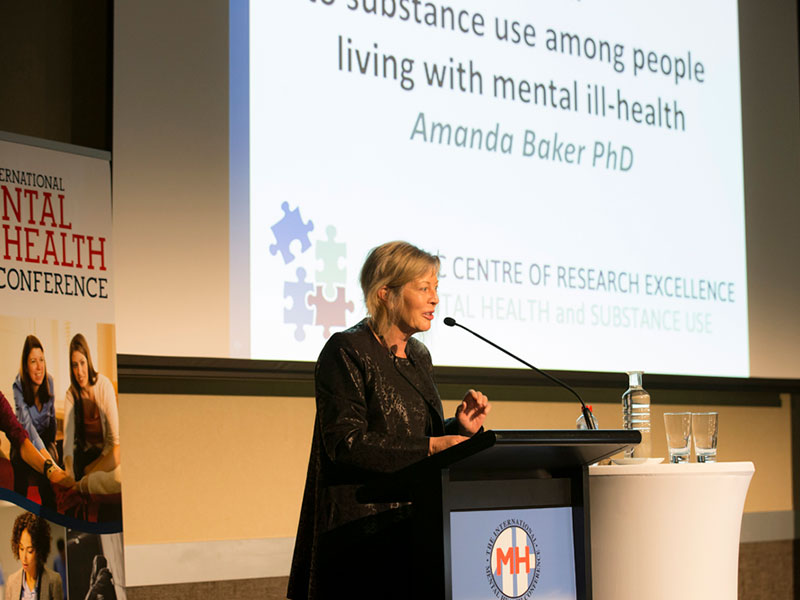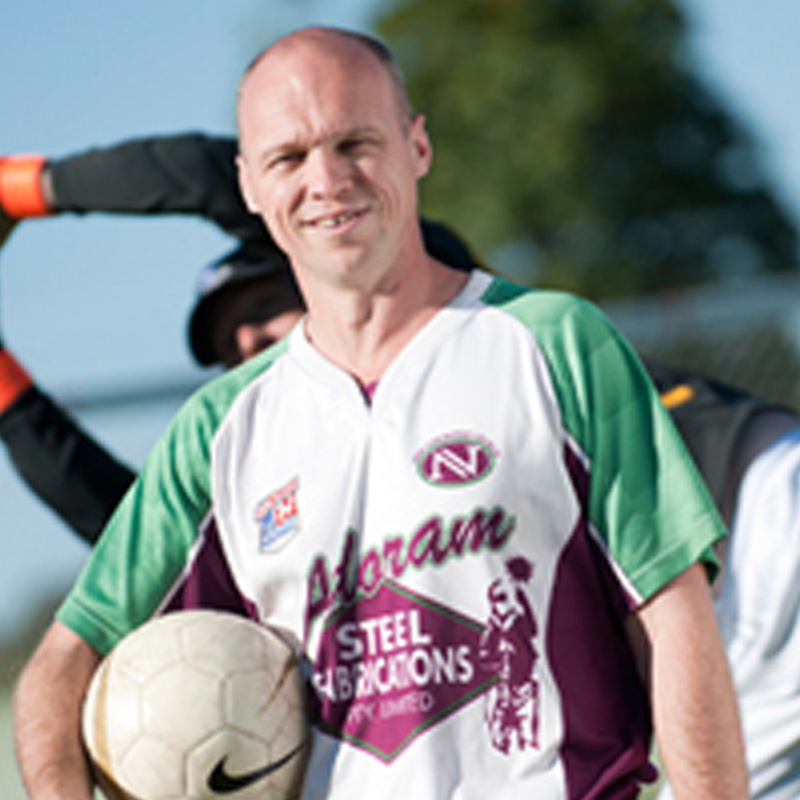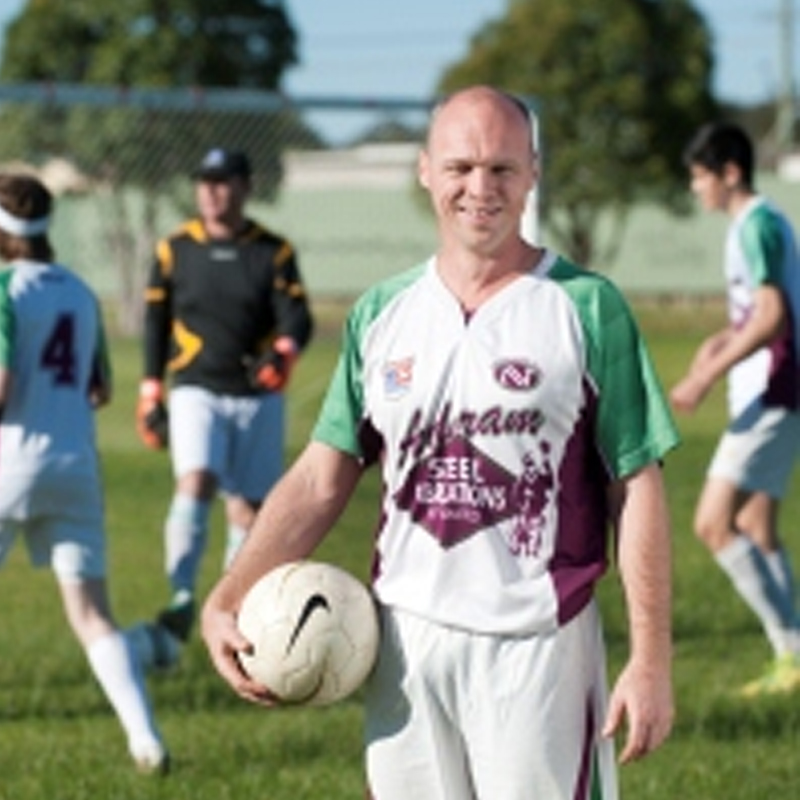Conjoint Associate Professor Gary Baker
Conjoint Associate Professor
School of Medicine and Public Health
- Email:g.baker@newcastle.edu.au
The mysteries of sperm function
Tenacious and audacious in equal measure, Associate Professor Mark Baker is seeking to crack the genetic code of male infertility.
 Diagnosing male factor infertility – which accounts for half of all Assisted Reproduction Technologies (ART) procedures in Australia – is akin to solving a 5000 odd-piece jigsaw puzzle. Some pieces or answers, like reduced sperm
number and motility, are right in front of you; they're big and obvious, and usually the first to be picked up and put down by novice game players. They frame the puzzle and make it easier to work inward. Then there are some pieces, like genetic differences, that are much smaller in size or even hidden;
they're not your typical go-tos and they're not easy to place. But they are necessary to complete the picture.
Diagnosing male factor infertility – which accounts for half of all Assisted Reproduction Technologies (ART) procedures in Australia – is akin to solving a 5000 odd-piece jigsaw puzzle. Some pieces or answers, like reduced sperm
number and motility, are right in front of you; they're big and obvious, and usually the first to be picked up and put down by novice game players. They frame the puzzle and make it easier to work inward. Then there are some pieces, like genetic differences, that are much smaller in size or even hidden;
they're not your typical go-tos and they're not easy to place. But they are necessary to complete the picture.
Associate Professor Mark Baker, touted as a pioneer of sperm proteomics, is leading worldwide efforts to explore and understand the latter.
I study the structure and function of proteomes
"These are the entire sets of proteins that are expressed by genomes."
The professional researcher, who was awarded a National Health and Medical Research Council Career Development Fellowship in early 2012, uses mass spectrometry to illustrate the chemical composition of larger molecules and cells. Spanning the life sciences, medicine and engineering arenas, this work is housed in a state-of-the-art laboratory at the University of Newcastle.
"The implications of our research are widespread," Mark affirms.
"About 1 in 15 men are infertile."
"Medicare-funded statistics point to an IVF success rate of just 22 per cent, which is equally concerning."
"It's important we develop more efficient and effective ways of finding the best sperm."
Divide and conquer
Taking a "roundabout route" to get to this point, Mark began his research career in the cancer field. The energetic educator and innovator undertook a PhD at Melbourne's Monash University in 1999, principally using it to investigate the relationship between chemotherapy and cell death.
"We wanted to look at what the chemical treatment is doing to the body," he asserts.
"It's basically a poison."
Seeking to gain a more intricate understanding of the cell cycle during his three-year probe, Mark closely observed the mechanism by which microscopic units were dying during the chemotherapy process.
"Cells that are dividing are more susceptible to cell death than cells that aren't dividing," he explains.
"Cancers can be destroyed as the cells die, but that happens to be how people lose their hair and the lining of the stomach as well."
Back to basics
Mark relocated to Newcastle after his PhD was conferred in 2002, linking up with Laureate Professor John Aitkin and the University's influential Reproductive Science Group. Inspired by new technologies at the time, the creative collaborator looked to put an unusual twist on his PhD theme.
"Proteomics allowed us to compare the difference between normal biological cells and cancer cells," he states.
"We can do the same thing with male reproductive cells - compare the difference between those belonging to fertile men and those belonging to infertile men and find out what's missing."
"It's a fascinating question."
From 2002-2011, Mark also undertook some basic science research on the behaviours and movement patterns of sperm. This time exploring the differences between mature cells and immature cells, the expert sought to understand the "hows" and "whys" of their storage and travel.
"We found that a sperm is immotile in the testes and cannot recognise the egg until it reaches the bottom of the epididymis," he illuminates.
"We found that immature sperm undergo changes in their phosphorylation status too."
"Some of the motor proteins become 'oiled' and this enables the tail to become motile, which is necessary for fertilisation."
"Essentially, the whole head and surface of the sperm are remodelled from the early regions to the later regions."
Spot the difference
Still endeavouring to define the differences between the sperm of fertile men and the sperm of infertile men, Mark is aiming to one day soon diagnose and prognose 80-90% of male infertility cases. Working on the proviso that "the more cases looked at, the more that is found," the ambitious academic is in the process of analysing more than 100 samples locked away in his laboratory.
"At the moment we can probably detect 30%," he declares.
"Some of the guys are missing proteins in the head area, which means they're unable to recognise and bind with the egg."
"Others are missing a protein in the neck area, so the head and tail actually fall apart over a period of time."
"Proteins in the tail area are stopping the sperm from being normally motile as well."
Believing such patterns will "become repetitive" with enough data, Mark is hoping to have a diagnostic framework completed in 2-3 years' time.
"The hardest thing for us is obtaining donations," he acknowledges.
"At the moment, we've had to go to Brazil."
"We need interested, local men to come forward."
"Within a week we can do five samples and determine what's missing within them, so it doesn't take very long."
At the same time, Mark is collaborating with neurology expert Dr Neil Spratt on a clinical stroke research project. Again attempting to figure out the "whys" behind the "what is," the duo is seeking to compare the difference between normal cerebral spinal fluid and cerebral spinal fluid that belongs to patients who've had a "minor stroke."
"In a period of 24 hours while they're recovering, the latter group will often have another, more major stroke," the reproductive scientist elucidates.
"It's killing a lot of people."
Already identifying a handful of molecules responsible for causing the second, lethal stroke, the pair is eager to move on to the prevention stage and develop a number of single-targeted inhibitors.
Changing tactics for changing times
Keen to move past mere motility and morphology when it comes to analysing semen samples, Mark is pushing for big transformations in the way suspected infertilities are investigated in Australia. The University of Newcastle Research Fellow has been doing so since he made the switch to translational research in 2012.
"Females have to undergo invasive laparoscopies and pelvic examinations," he reveals.
"We want the focus to go instantly to the male."
"It's so easy to get an ejaculate and bring it to the lab."
"Within an hour we can have a diagnosis as to whether the couple can conceive or not."
The mysteries of sperm function
Tenacious and audacious in equal measure, A/P Mark Baker is seeking to crack the genetic code of male infertility.
Research of substance
Professor Amanda Baker is a National Health and Medical Research Council Senior Research Fellow at the University of Newcastle. An award winning innovator, she specializes in the treatment of co-existing mental health and substance use problems.
 Early in her career as a clinical psychologist, Professor Baker identified a lack of integration between mental health supports, and drug and alcohol treatments as a major barrier to behaviour change.
Early in her career as a clinical psychologist, Professor Baker identified a lack of integration between mental health supports, and drug and alcohol treatments as a major barrier to behaviour change.
Rather than treating co-occurring problems in a consolidated manner, patients were often refused treatment from one targeted service, if they also needed treatment from the other.
"What drives me are the dualities in the system between mental health and drug and alcohol," Amanda explains.
People often have more than one problem, and mental health and drug and alcohol use go hand in hand.
Over one hundred and fifty publications later - including five national amphetamine treatment clinician guidelines and eight treatment manuals for comorbidity - Amanda and her team have made significant progress toward the recognition of the need to integrate the treatment of co-existing issues.
INTEGRATION AND COMMUNITY
By the time Amanda graduated in the early 1980s, the push to de-institutionalise mental health in Australia had begun in earnest. Research and practice from around the world showed that mental health patients, who had previously been institutionalised, had better health outcomes when transitioned back into the community.
A stint practicing in community health in Manchester, the United Kingdom, gave Amanda a new perspective on how psychologists could successfully aid this transition. During this time, Amanda experienced first-hand the positive outcomes of a system where practice and research were highly integrated, and was eager to facilitate a change in this direction back home.
Returning to Australia three years later, Amanda took up a position at the National Drug and Alcohol Research Centre, where she completed her PhD on reducing HIV risk in injecting drug users, before working in the drug and alcohol facility at Westmead Hospital, Sydney.
In 1995 Amanda was appointed to head up a graduate course in Drug and Alcohol Studies for clinicians at the University of Newcastle. Armed with experience in the clinical and research spheres of both mental health, and drugs and alcohol, Amanda's input into the Faculty of Health and Medicine has been invaluable. Her attention shifted from teaching and research to research in 2003, where has been continuously funded by NHRMC fellowships ever since. Known as a generous mentor and supporter of early career researchers, Amanda was appointed Deputy Head of the School of Medicine and Public Health (Research) in 2010 for a three year term.
METHAMPHETAMINE TREATMENT OPTIONS
A consistent area of focus in Amanda's research has been the use of methamphetamines by people with mental health problems. Leading a Commonwealth funded trial in the early 2000s, Amanda found counselling to have favourable outcomes for methamphetamine users. The treatment framework was disseminated nationally, but unfortunately, the model was not sustained.
Amanda points to several factors including poly-drug use, presenting behaviours such as paranoia or violence, and sector worker turnover as barriers to methamphetamine users accessing drug and alcohol services.
"Methamphetamine is the drug that makes you confront that overlap between mental health and substance use," she says.
"It really draws out the psychotic symptomatology and edginess in people."
"Users can be angry or violent, and workers need training to be confident on how to proceed from there."
As immediate past president of the Australasian Professional Society for Alcohol and other Drugs (APSAD) Amanda represented this peak body in consultations with the Federal Government's National Ice Taskforce. Called upon to help inform the community response to ice use as a major public health issue in Australia, she presented at the National Methamphetamine Symposium in early May 2015.
WHERE THERE'S SMOKE
More recently, another drug has almost completely captured Amanda's attention.
"In the last ten years or so I have become very interested in tobacco, the drug that everyone forgets."
"Because it is legal, people don't understand that it can create so much harm," she adds.
Amanda has been an advisor during the transition of forensic hospitals to smoke-free facilities, and is currently working on a phone delivered smoking cessation program for people with mental health problems in partnership with Quitline Victoria.
"I'm very passionate about trying to help people with mental health problems give up smoking," she declares.
"They die 20 years earlier than people in the general community from tobacco related causes."
Amanda is also currently involved in an NHMRC trial, testing the efficacy of iPad delivered smoking cessation programs targeting hospital patients who have suffered orthopaedic trauma.
The trial, led by Associate Professor Billie Bonevski, is attempting to decrease the healing time and amputation risk of participants by helping them quit smoking.
WHERE TO FROM HERE
When asked about her future, Amanda conveys her enthusiasm for the Quitline telephone delivered smoking cessation program. She sees this as her direct future, evaluating phone interventions in real life delivery.
"I think telephone interventions are where I can make an impact," she avows.
"It's always assumed that people with severe mental illness need intensive individual intervention with face-to-face treatment."
"But we have proved that phone intervention, which everyone loved, was simpler, briefer and just as effective."
Amanda also speaks eagerly about a related project she is undertaking with Doctor Peter Kelly from the University of Wollongong. This project trains peer workers to deliver healthy living interventions with a focus on diet and activity, to people with mental health problems, again via telephone.
Although it may seem incongruous for Amanda to be focusing on diet and activity she points out that changing dietary intake (like levels of fruit and vegetables) and reducing TV watching may impact positively on the other behaviours that affect cardio-vascular health – smoking, alcohol, and snacking on high fat foods.
"They are all addictive behaviours," she explains.
"In today's society, you can buy so much food, so much packaged food. Forty years ago it wasn't available. Food really is the new tobacco."
Research of substance
Professor Amanda Baker is a National Health and Medical Research Council Senior Research Fellow at the University of Newcastle. An award winning innovator
Kicking goals
Dr Mark Baker has picked up the pace of sperm cell research by harnessing the power of proteomics.

There is a competitive side to Dr Mark Baker, who likes to keep fit and, at 37, still enjoys the challenge of matching strides with younger opponents on the soccer field. But the race Baker is most keen to win is the one to develop a male version of the contraceptive pill – and the proteomics expert believes his research team at the University of Newcastle has a real chance of achieving that goal.
"We are the world leaders in sperm proteomics," points out Baker, who was the first researcher to create a complete inventory of the proteins in sperm and has established a state-of-the-art proteomics laboratory at the University. "The work we do is part of a worldwide effort but we are recognised as pioneers and the most progressive group in our field."
Baker joined the University's influential Reproductive Science Group, led by Laureate Professor John Aitken, after being awarded a PhD from Monash University in 2002. Aitken, who specialises in sperm cell biology, recognised the potential in combining their areas of expertise towards the common goal of solving the mysteries of male fertility.
Whilst Baker's ultimate goal is to develop a male contraceptive, his research has equal potential to assist men who are infertile, as it is necessary to understand the mechanisms of infertility in order to mimic the condition with a male contraceptive. In identifying and publishing the sperm proteome, Baker advanced the number of known proteins from less than 40 to more than 1200. He and the research team have subsequently narrowed down that list of proteins to a handful that can potentially be targeted by fertility drugs.
"One of the important criteria is that the protein is found only in the testes, because if you are designing a drug that inhibits a protein you don't want it to affect other parts of the body," Baker explains. "So, we have identified a number of proteins that we know are both unique to the testes and are vital for fertility. We are now moving into the next phase of the research, which is designing a drug to target them."
Baker's work has attracted the attention of Bayer (formerly Bayer Schering Pharma), one of the first companies to market the contraceptive pill back in the 1960s. He has also established collaborations with leading international research groups in the field.
"The implications of our research are widespread when you consider that about half of all pregnancies in Australia are unwanted or unplanned and that there are about 250 abortions for every 1000 live births," Baker asserts. "There are also thousands of women who suffer side effects from contraception and there is an inextricable link between poverty and high birth rates in developing counties. As you can imagine, there is a real global imperative to improve options by developing a male contraceptive. At the same time, up to 10 per cent of the male population is infertile, so we want to be able to help them as well."
Baker has contributed his expertise in identifying the protein structure of cells to other interesting collaborations with leading University health researchers. He is currently working with Professor Hubert Hondermark on a project to detect metastatic potential in breast cancer cells and with Conjoint Professor Jim Denham to determine new biomarkers for prostate cancer. He is also working with members of the translational stroke research team on a project investigating indicators of stroke in cerebral spinal fluid.
Baker holds a National Health and Medical Research Council (NHMRC) Career Development Fellowship to research sperm motility and is an investigator on several projects supported by the NHMRC. Late last year he received the 2011 Early Career Researcher Award sponsored by the Hunter Medical Research Institute (HMRI) fundraising group PULSE.
Baker's research in sperm-egg recognition and proteomic analysis of sperm cells is internationally recognised and has been cited more than 950 times. The proteomics laboratory he was instrumental in establishing, with its world-class mass spectrometry equipment, has made a broad contribution to research at the University of Newcastle, supporting work across the disciplines of life science, science, medicine and engineering as well as research from HMRI and international and national collaborations.
Two minds are better than one
The powerful combination of Laureate Professor John Aitken's vast knowledge of sperm cell biology and Dr Mark Baker's proteomics prowess makes the University of Newcastle's Reproductive Science Group a formidable force in the research field of sperm function and male fertility.
"John and I decided seven years ago that we needed to investigate the proteins in sperm cells to understand the mechanisms of fertility," Baker advises. "We saw the potential in it and went after it, and the University has backed us all the way. We quickly got into the field and we have raised the bar."
Baker believes he has benefited greatly from working with Aitken, one of the world's most esteemed reproductive scientists. "He has been my primary mentor, but it is a relationship built on mutual respect," Baker emphasises. "There is a willingness to work together but also a willingness to listen to each other's points of view – and that is critical to successful research: to be able to agree but also disagree."
Aitken describes Baker as"an ideal example of how postdoctoral researchers can blossom into fully-fledged professional scientists when the University supports their careers."Now, Mark is generating research income in his own right that will more than repay the investment the University has made in developing his research portfolio."
Visit the Centre for Reproductive Science website
Visit the HMRI website
Kicking goals
The Centre for Reproductive Science works to improve the health of pregnant women and provides key information on the determinants of 'A Healthy Start to Life'
Conjoint Associate Professor Gary Baker
Position
Conjoint Associate Professor
School of Medicine and Public Health
College of Health, Medicine and Wellbeing
Contact Details
| g.baker@newcastle.edu.au |



